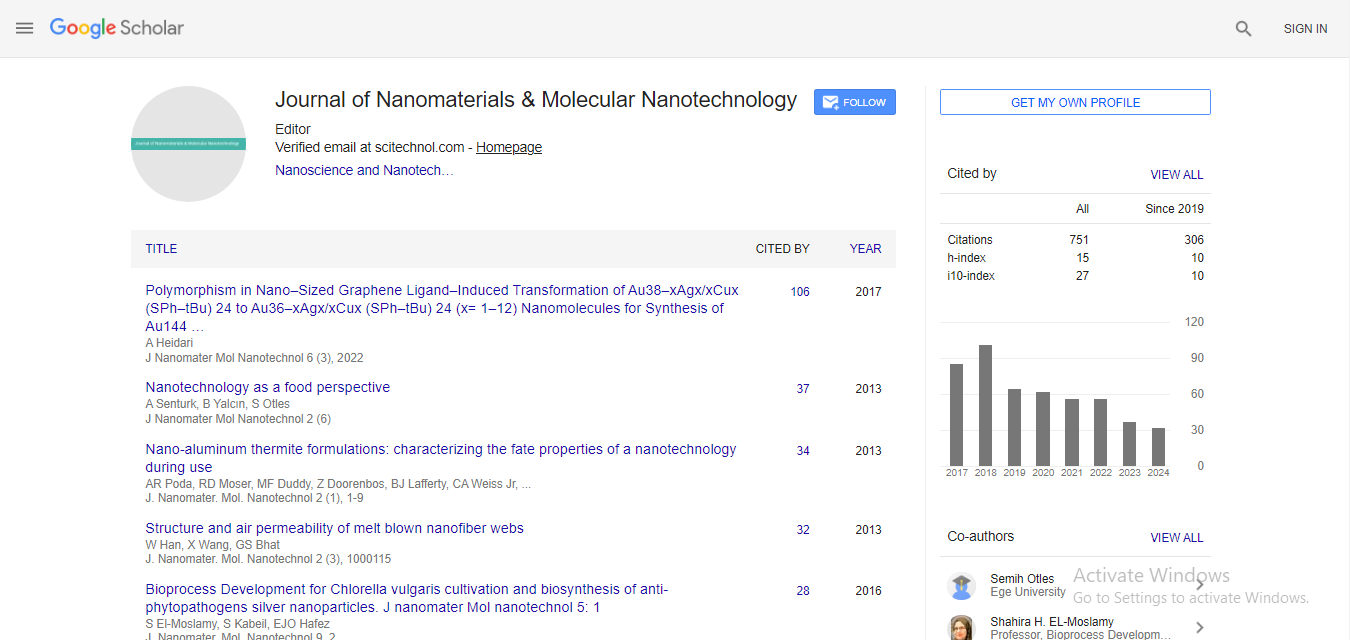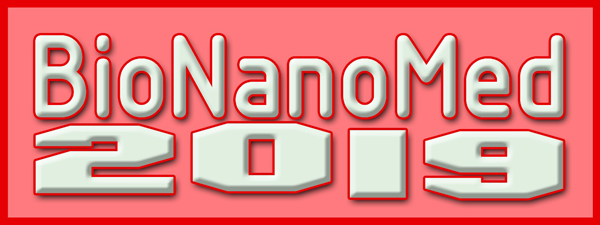Commentary, J Nanomater Mol Nanotechnol Vol: 11 Issue: 1
Nanotechnology in the Development of Pharmaceuticals
Jean Owen *
Department of Biotechnology, Federal University of Uberlandia, Uberlandia, Brazil
*Corresponding author: Jean Owen
Department of Biotechnology, Federal University of Uberlandia, Uberlandia, Brazil
E-mail: jeanowen@gmail.com
Received date: 15 December, 2021, Manuscript No. JNMN-21-58129;
Editor assigned date: 17 December, 2021, PreQC No. JNMN-21-58129 (PQ);
Reviewed date: 31 December, QC No. JNMN-21-58129;
Revised date: 07 January, 2022, Manuscript No. JNMN-21-58129 (R);
Published date: 14 January, 2022, DOI: 10.4172/2324-8777.2022.11(1).1000317
Citation: Owen J (2022) Nanotechnology in the Development of Pharmaceuticals. J Nanomater Mol Nanotechnol 11:1.
Keywords: Nanotechnology, Pharmaceuticals
Description
Nanotechnology has given a completely unique perspective to human understanding and brought revolutionary changes within the field of life sciences, together with drug delivery, medicine, food, and also the production of biomaterials appropriate for applications within the field of medication. This has resulted in new therapies, drug delivery systems, and biomaterials for implants or corrective. Nanoparticles have necessary potential applications in administration of therapeutic agents and in diagnostic procedures. The nanoparticulates drug delivery system offers many blessings over typical indefinite quantity forms, as an example reduced toxicity, increased bio-distribution, and improved patient compliance. Nanoparticle-based drug delivery systems, like liposomes, micelles, nanoemulsions, nanocapsules, solid macromolecule nanoparticles, magnetic nanoparticles, nanogels, albumen nanoparticles, so on have nice potential to be therapeutically effective systems for human and animal diseases. Such delivery systems hold nice potential to beat a number of the barriers to economical targeting of cells and molecules in inflammation and cancer. There’s an occasion to beat issues of drug resistance in target cells and to facilitate movements of medication across the barrier. The challenge, however, remains the precise characterization of molecular targets and making certain that these nanoparticles area unit directed toward the targeted organs to forestall adverse effects on healthy tissues. To require additional nanotechnology-based merchandise into the clinic, it's necessary to deal with the chance problems at the same time, together with any risks ensuing from the nanoscale properties of the materials used.
Compared to ancient indefinite quantity ways, the Novel Drug Delivery Systems (NDDS) give numerous blessings. Within the previous couple of years, the interest shifted to works centered on the novel drug delivery ways for little and huge molecular drug carriers utilizing particulate drug delivery systems likewise. It’s evident from the last decade as determined in redoubled variety of patents during this field that the technology has evolved hugely. Drug carriers used by this novel technology embrace liposomes, dendrimers, chemical compound nanoparticles, magnetic nanoparticles, solid macromolecule nanoparticles, and carbon nanomaterial’s. Numerous types of polymers are employed in the assembly of nanocarriers. Nanocarriers area unit mixture systems variable in size from ten to one thousand nm. This technology is currently accustomed determine, manage and monitor various diseases and physical ways to change and enhance the pharmacokinetic and pharmacodynamics properties of specific sorts of drug molecules. Nanoparticles is developed by variety of techniques together with ionic gelation, crosslinking, coacervation/ precipitation, nanoprecipitation, spray drying, emulsion- driblet concretion, nano sonication techniques, etc. many ways area unit used with that these nanoparticles is characterized. These ways embrace nuclear resonance, optical research, atomic force research, gauge boson correlation spectrographic analysis and microscopy, surface charge, in-vitro drug unleash, etc.
Nanoenabled Technology
Before considering intimately specific patents and patent applications using engineering within the pharmaceutical field, it's maybe applicable to 1st contemplate what's to be understood by the term ‘nanotechnology’. However, even scientists within the field contend that ‘it depends on UN agency you ask. Some analyzers use the term to explain research that's applied at the molecular and/or atomic level. Others contemplate the particular sizes of the materials being studied however some contemplate the acceptable size dimensions to be between one and a hundred nanometres, and not merely but one metric linear unit (1000 nanometres). Indeed, on reviewing the patent literature, it's noted that some patent documents consult with, as an example, nanoparticles, once clearly the sizes area unit within the microns vary. Withal, for the needs of this text, i'll usually consult with patents that describe materials that have a minimum of one dimension of one thousand nanometres. Though this text can specialize in such ‘nano-sized’ merchandise, thought ought to even be given to what could also be represented as ‘nano-enabled’ technology. Nanoenabled technology could also be thought of as technology that has utilized materials that adapt to the micromillimeter dimension necessities, however the ensuing material might not be remotely nano-sized. As an example, the surface of a medical device could also be changed employing a nanocrystalline material, so as to, as an example, build the device additional bio-compatible. The surface-modified medical device isn't nano-sized, however withal engineering has compete its half in developing a nano-enabled product. Thus, it's my intention to conjointly consult with some patents about such nanoenabled merchandise. Withal, with such a speedily increasing field, it's not possible in an editorial like this to cope with all aspects, and per se, I will solely serve to convey a flavour of the sector and what could also be expected within the future.
Engineering Techniques
I applied a patent search victimization the keywords ‘nanometer’ and ‘pharmaceutical’ over the years 1993–2003. The search was applied victimization the Delphion search web site, gazing the complete text and claims of revealed U.S. and European Patent Convention (EPC) patents and patent applications, likewise as Patent Cooperation written agreement applications. The results area unit shown in Figure one wherever it will been seen that there has been a close to exponential increase in recent years. Having analysed the small print of the patents that were known, there seems to be variety of general trends developing within the drug field. Engineering techniques particularly, seem to own been used and proprietary in relevance drug delivery, significantly victimisation nanoparticles, dendrimers, nanoemulsions, and also the like, and conjointly to increasing/improving drug solubility/bioavailability. There are an excellent several patents/patent applications involved with treatments using nucleic acids, like sequence medical care, antisense molecules and meddlesome polymer techniques. The terribly size of supermolecule molecules, usually puts them within the micromillimeter vary, however, generally no vital technological process has been applied on the molecules themselves. Thus, for the needs of this text, I don't shall contemplate patents/patent applications in the main about supermolecule based mostly therapies unless the delivery of the supermolecule itself employs engineering techniques.
It seems that every one sorts of someone, from Universities to small/medium-sized enterprises, to massive pharmaceutical corporations, area unit filing patent applications in relevance pharmaceutical engineering. However, maybe not shocking, it's usually the colleges and small/medium-sized enterprises that seem to be seeking to get broad-based platform technology patents, whereas the massive pharmaceutical corporations typically file a lot of narrower specific formulation-type patents. This is often not entirely shocking and certain to result to the massive pharmaceutical corporations forming wholly/partly owned subsidiaries to hold out analysis and development into general drug delivery, or outsourcing/ collaborating with specialist smaller corporations, instead of conducting the work in-house.
 Spanish
Spanish  Chinese
Chinese  Russian
Russian  German
German  French
French  Japanese
Japanese  Portuguese
Portuguese  Hindi
Hindi 



